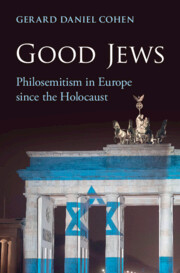Refine search
Actions for selected content:
115 results

Good Jews
- Philosemitism in Europe since the Holocaust
-
- Published online:
- 19 September 2025
- Print publication:
- 07 August 2025
Chapter 16 - Richard Wagner
- from Part V - Schoenberg’s Others
-
-
- Book:
- Schoenberg in Context
- Published online:
- 04 September 2025
- Print publication:
- 04 September 2025, pp 165-173
-
- Chapter
- Export citation
Chapter 32 - Poetry, Literature and Language
- from Part VIII - Ideas, Beliefs and Interventions
-
-
- Book:
- Schoenberg in Context
- Published online:
- 04 September 2025
- Print publication:
- 04 September 2025, pp 316-324
-
- Chapter
- Export citation
Chapter 28 - Music Criticism and Music Critics
- from Part VII - Performers and Critics
-
-
- Book:
- Schoenberg in Context
- Published online:
- 04 September 2025
- Print publication:
- 04 September 2025, pp 276-284
-
- Chapter
- Export citation
Chapter 29 - Religion
- from Part VIII - Ideas, Beliefs and Interventions
-
-
- Book:
- Schoenberg in Context
- Published online:
- 04 September 2025
- Print publication:
- 04 September 2025, pp 287-297
-
- Chapter
- Export citation
Chapter 4 - Mödling
- from Part I - Schoenberg in Place
-
-
- Book:
- Schoenberg in Context
- Published online:
- 04 September 2025
- Print publication:
- 04 September 2025, pp 31-38
-
- Chapter
- Export citation
6 - “The Long 1960s” and the Jews (1960–1980)
-
- Book:
- Good Jews
- Published online:
- 19 September 2025
- Print publication:
- 07 August 2025, pp 171-214
-
- Chapter
- Export citation
2 - From Antisemitism to Tactical Philosemitism (1945–1960)
-
- Book:
- Good Jews
- Published online:
- 19 September 2025
- Print publication:
- 07 August 2025, pp 25-59
-
- Chapter
- Export citation
20 - “Judenforschung”: Nazi Jewish Studies
-
-
- Book:
- The Cambridge History of the Holocaust
- Published online:
- 16 May 2025
- Print publication:
- 12 June 2025, pp 420-439
-
- Chapter
- Export citation
15 - Hitler and the Nazi Party
-
-
- Book:
- The Cambridge History of the Holocaust
- Published online:
- 16 May 2025
- Print publication:
- 12 June 2025, pp 309-327
-
- Chapter
- Export citation
11 - The Holocaust in Eastern European Memory and Politics after the Cold War
- from Part II - Geography
-
-
- Book:
- The Cambridge History of the Holocaust
- Published online:
- 16 May 2025
- Print publication:
- 12 June 2025, pp 256-284
-
- Chapter
- Export citation
24 - International Responses to Nazi Race and Jewish Policy, 1933–1939
-
-
- Book:
- The Cambridge History of the Holocaust
- Published online:
- 16 May 2025
- Print publication:
- 12 June 2025, pp 502-522
-
- Chapter
- Export citation
10 - Antisemitism in Interwar Europe
-
-
- Book:
- The Cambridge History of the Holocaust
- Published online:
- 16 May 2025
- Print publication:
- 12 June 2025, pp 198-219
-
- Chapter
- Export citation
11 - Race-Thinking, Völkisch-Nationalism, and Eugenics
-
-
- Book:
- The Cambridge History of the Holocaust
- Published online:
- 16 May 2025
- Print publication:
- 12 June 2025, pp 220-247
-
- Chapter
- Export citation
8 - Holocaust Denial and Antisemitism
- from Part I - History
-
-
- Book:
- The Cambridge History of the Holocaust
- Published online:
- 16 May 2025
- Print publication:
- 12 June 2025, pp 188-212
-
- Chapter
- Export citation
17 - Antisemitic Policy in the Early Years of the Third Reich
-
-
- Book:
- The Cambridge History of the Holocaust
- Published online:
- 16 May 2025
- Print publication:
- 12 June 2025, pp 351-372
-
- Chapter
- Export citation
21 - Belonging and Belongings: The Dispossession of German Jews
-
-
- Book:
- The Cambridge History of the Holocaust
- Published online:
- 16 May 2025
- Print publication:
- 12 June 2025, pp 440-460
-
- Chapter
- Export citation
13 - Communism and Anticommunism
-
-
- Book:
- The Cambridge History of the Holocaust
- Published online:
- 16 May 2025
- Print publication:
- 12 June 2025, pp 268-287
-
- Chapter
- Export citation
18 - Popular Participation in Anti-Jewish Policy up to 1938
-
-
- Book:
- The Cambridge History of the Holocaust
- Published online:
- 16 May 2025
- Print publication:
- 12 June 2025, pp 373-392
-
- Chapter
- Export citation

The Cambridge History of the Holocaust
-
- Published online:
- 16 May 2025
- Print publication:
- 12 June 2025
